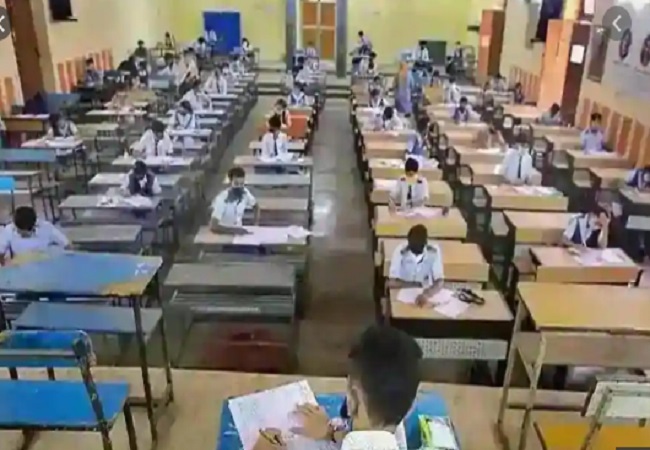



Introduction:
The National Education Policy 2020 is a landmark document, a guiding code and a blue print in the history of education in India, which has been approved by the government after wide ranging consultations. The policy is comprehensive, holistic, far sighted and it will play a great role in the future growth of the entire nation. The policy spaces a welcome stress on a holistic, learner centred, flexible system that seeks to transform India into a vibrant knowledge society. It rightfully balances the rootedness and pride in India as well as acceptance of the best ideas and practices in the world of learning from across the globe.
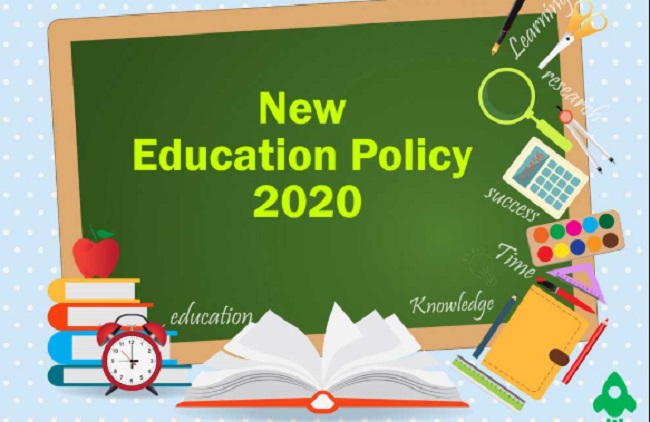
India has the second-largest population on earth, after its neighbouring country China and within a few years it may overtake the entire population of China. In the last twenty years the Indian population has grown by a number greater than that of the entire population of the United States. The consequences of population pressure are well known, poverty, unemployment, shortage of food, shortage of pure drinking water, shortage of housing, shortage of healthcare facilities, shortage of quality education, shortage of nutrition, ecological imbalances, deforestation, degradation of agriculture, and so on. But, India do not have the sufficient resources to create new Universities, Colleges, Schools, Hospitals, Housing, Fooding, clothing, etc. and many more each year as compared to the increased population. Since independence, India have adopted Five Year Planning and have introduced thousands of Schemes, Programmes, Projects, Acts, Rules, Regulations, to provide basic minimum facilities to its citizens. So, at present the biggest challenge before the Government of India is to solve all these problems with its limited resources. The challenge of Indian democracy is to meet the basic material needs of all Indians while accommodating their diverse aspirations within the national dream.
Human resource development is considered as one of the significant factors for accomplishing economic growth of a country and has a far-reaching impact on socio-economic changes as it is observed throughout the country. Development of Human Resources of a country is impossible without mass education. In fact ,no one can meaningfully participate in the developmental activities of a country nor can reap the benefit of development ,unless he or she is educated Thus ,much of the development of other sectors – agriculture, infrastructure ,Industry and other allied sectors depends on the level of human resource development of a country.
Key highlights of School Education:
Some of the basic features of the National Education Policy-2020 are highlighted here:
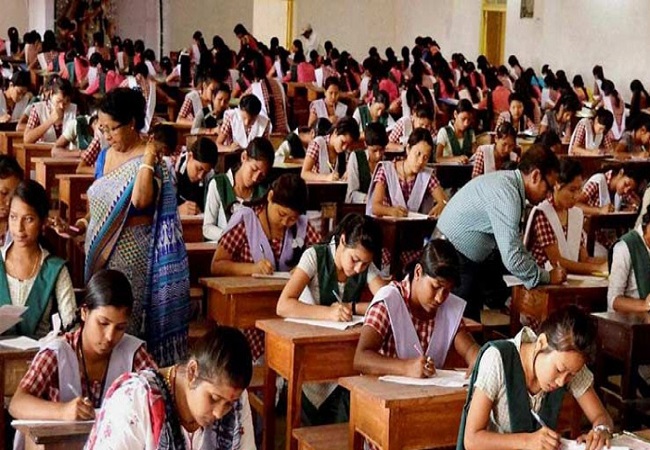
1) The policy aims to universalize the education from preschool to secondary level with 100% Gross Enrolment Ratio (GER) by 2030.
2) The policy also aims to universalize the pre-primary education by 2025 and provide foundational literacy and numeracy for all by 2025.
3) It also aims to bring 2 crore out of school children back into the mainstream through an open schooling system.
4) The current 10+2 system to be replaced by a new 5+3+3+4 curricular and pedagogical structure corresponding to ages 3-8, 8-11, 11-14, and 14-18 years respectively.
5) Class 10 and 12 board examinations to be made easier, to test core competencies rather than memorised facts, with all students allowed to take the exam twice.
6) School governance is set to change, with a new accreditation framework and an independent authority to regulate both public and private schools.
7) A new independent State School Regulatory Authority (SSRA) to be created.
8) Emphasis on Foundational Literacy and Numeracy, no rigid separation between academic streams, extracurricular, vocational streams in schools.
9) Vocational Education to start from Class 6 with internships.
10) Teaching up to at least Grade 5 to be in mother tongue/regional language. No language will be imposed on any student.
11) It aims to protect and promote our culture through the study of classical languages, mother tongues and regional languages.
12) Assessment reforms with 360 degree Holistic Progress Card, tracking Student Progress for achieving Learning Outcomes
13) A new and comprehensive National Curriculum Framework for Teacher Education (NCFTE) 2021, will be formulated by the National Council for Teacher Education (NCTE) in consultation with National Council of Educational Research and Training (NCERT).
14) By 2030, the minimum degree qualification for teaching will be a 4-year integrated B.Ed. degree.
It is indeed a very tough job to prepare such a gigantic framework for the whole nation. Actually, National Education Policy looks at the education spanning the formative years of a child’s life as “organic continuum” that focusses not only on the need to improve cognitive skills, but also encourages to restore and redesign our system to promote the critical thinking ability. When we look back to the pre-historical times, it is to be found that India was an abode of the learned and the seekers of knowledge. The Universities like Nalanda and Thakshasila commanded respect on an international level. Our history is further enriched with thinkers, philosophers, mathematicians and men of Science. However, owing to years of foreign rule and colonial rule that devastated the nation, one of the worst affected was undoubtedly the education sector.
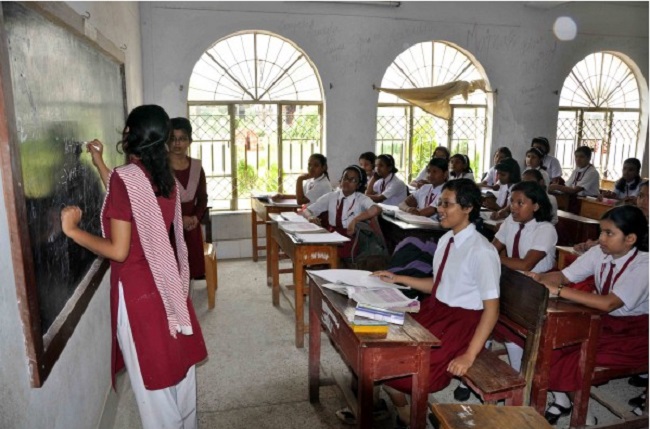
The small state of Tripura was treated as one district for several decades. In the year 1972 the state was divided into three districts. Again, in 1995, it was divided into four districts for administrative conveniences. On 21st January 2012, Tripura has been divided into as many as eight districts, 23 Sub-divisions and 58 Blocks. According the Census Report of India 2011 the total population of Tripura is 36,71,032, out of which about 14.05% (Tendulkar Methodology, 2011-12, Planning Commission) of the people are living below the poverty line and density of population is 350 per square kilometer. Tripura Legislative Assembly had passed the Tripura Tribal Areas Autonomous District Council (TTAADC) Bill on 3rd march 1998. The total area of the TTAADC is about 7132.56 sq. kms. That means 68.10 per cent of land has been brought under the control of the TTAADC.
Tripura, a hilly and tiny kingdom, has economic, cultural and demographic diversity and high density. Tripura’s very location indicates socio-economic diversity and variations in the rural and the urban ways of life. The western part of Tripura has similarity with eastern Bengal, while the eastern part of Tripura has similarity with Assam, Mizoram and Manipur.
Tripura has a dual society, a Tripuri society in the eastern hills and a Bengali society in the western valley. The Tripuri society consists of mainly 19 communities like, Tripuri, Reang, Chakma, Jamatia, Mog, Halam, Kuki, etc. and these people speak various dialects. The Bengali society consisted of various castes and communities; they settled in the alluvial, low valley of the river Meghna system, which suits their mode of production through plough cultivation on wet lands. The demographic composition has largely contributed in forming a composite cultural pattern in Tripura. An inquiry into the diversities and variations may be helpful to understand some more facts about the nature of school education in Tripura.
In Tripura schools are mostly run by the state government or by the private organisations. The medium of instruction is mainly English or Bengali. Kokborok and other tribal languages are also used. The Secondary schools are affiliated to CISCE, CBSE and the Tripura Board of Secondary Education.
As per Census 2001, literacy rate of the State is 73.20% against National rate 65.38%. Male literacy rate of the State is 81.00% (National rate 75.85%), and female literacy rate of State 64.9% (National rate 54.16%). Now, the literacy rate of Tripura is 96.82%. In Tripura in the year 2015-16, in total 5, 06,365 children of Primary & Upper Primary (I-VIII) have been benefitted under Mid-day Meal Scheme.
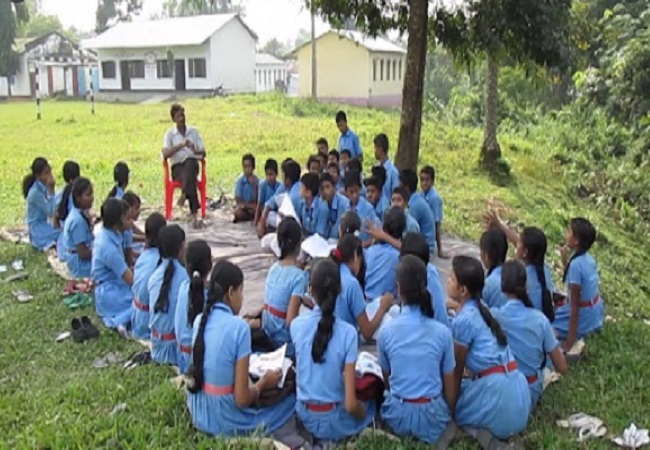
The Government of Tripura has given highest priority to education in its agenda since it attained statehood in 1972 and has been spending 12-14%of its annual budget for school education. The state School Education Department has been implementing some flagship programmes like Sarva Shiksha Abhiyan, Mid Day Meal .and Rastriya Madhyamick Shiksha Abhiyan for improving the status of elementary and secondary education in the state. Simultaneously, the state is making sincere efforts through its literacy programme to make the state fully literate. The present status of school education in Tripura is as follows:

To sustain and drive forward the progress and achievements, the School Education Department in Tripura is trying to focus on:-
1) Further enhancement of literacy rate to reach 100%.
2) More facilities to access elementary and secondary education.
3) Further reduction of gender-gap in enrolment, retention and completion of education.
4) More supports to students belonging to SC, ST, RM and OBC.
5) Removal of disparity at all level and ensure equity.
6) Improvement of quality of education at all levels.
7) Extension of ICT to all secondary level schools in phases.
Numerous studies have established that skilled teaching has a strong positive impact on student’s achievement. Children are far more likely to be motivated to learn and to persist in school if the curriculum and teaching methods are of high quality. The Government of Tripura is trying its level best to provide quality education at all levels in the state. But, due to some of the basic inherent problems and difficulties it fails to achieve the desired goals.
The Constitution puts education in the concurrent list, giving authority and responsibility to both the States and the Centre. So, both the governments with the principle of cooperative federalism should play a very positive, significant and effective role to implement the different aspects narrated in the new education policy. However, in this paper an attempt has been made to highlight some of the major challenges related to school education in Tripura. For proper and early implementation of the National Education Policy -2020 in Tripura these issues and problems should be taken into consideration.
1) In Tripura a good no. of students are not attending school regularly. Some of them are working as child labourer. The children are engaged in rag picking, motor garage workshops, transport sectors, manufacturing of potteries, hotel-restaurants, construction works, beedi making, plantation works, and so on. According to Census Report of India 2011 there were at least 5000 active working children, but in reality there are more numbers of children are working in different fields. Above all, in Tripura there are nearly 500 brick fields and the children of the migrant workers families working in the brick fields are deprived from the school education. The following table reflects the condition school dropouts in Tripura.

2) Mid-day meal scheme creates disturbances in teaching & learning process in the schools. In addition, there are several instances of poor quality of food served to the children; sometimes the children are not at all interested to take it. Sometimes the children become ill after taking contaminated food. It is very important to point out that private schools do not offer mid-day meal and still students rush to the private schools and if possible avoid government schools.
3) No detention policy is another remarkable provision introduced by the government in pursuance of the RTE Act; 2009. Examination is a sort of hurdle race which generates a competitive and struggling spirit in the minds of the students. The consequence of removal of this hurdle race is anarchic, degenerative and laxative.
4) According to the norms of RTE Act 2009, the student-teacher ratio at the primary level should be 40:01. But, it reveals that in Tripura (2014) the students-teacher ratio exists at 19:01. It means that in Tripura, there are thousands of surplus teachers at the primary level. In urban areas, the number of surplus teachers is abnormally high.
5) The moral degradation, lack of ethical values and lack of integrity on the part of many teachers is glaring in Tripura. Many of them are least interested to teach with dedication. They are found to indulge in drinking, smoking, playing cards, Satta, gambling, lotteries, petty business, benami business, and so on and so forth. Such types of teachers are not held in high esteem by the students and their guardians.
6) Private coaching centers are found scattered everywhere. The teachers, who privately coach some children, become lazy, tired, and careless in the class room. Some of the teachers entangle their students to join their coaching classes. Students cannot deny them as the marks are in the hands of the teachers.
7) In Tripura the teachers are appointed on the basis of political consideration and loyalty; no importance is given to the requisite qualifications of the candidates. Most of the teachers are not interested in teaching; rather they are associated with other activities like, agency of the private companies, small business, private tuition, poultry farming, cultivation, etc. The atmosphere in most of the class rooms remains dull, lifeless, inanimate, irksome, and cheerless.

8) Most of the schools do not have sufficient room for running normal classes. Above all most of the schools do not have the supply of pure drinking water. In some schools computers are available, but do not have electricity.
9) Some of the children have been swayed into addiction under unhealthy influences; they are often used as an instrument in drug trafficking.
10) In Tripura in all the government schools and colleges, the teaching staff works in a disempowering environment. The student’s councils dominate and dictate; collect membership fees in large scale; the leaders are as if de facto administrators.
11) The students in all the government schools and colleges work in a disengaging environment. Few students attend the classes and most of them loiter, gossip. They care little for their attendance and examination. The overall environment in the government schools and colleges is far from being academic.
12) In most of the school’s classrooms, playgrounds, boundary wall, offices, toilets are not properly maintained. The campus is not attractive, inviting, engaging and hygienic. Most of the academies are left unguarded, unprotected, open, free, unrestricted, and exposed. In some of the schools it has been observed that school lands have encroached by the neighbouring greedy people due to lack of supervision.
Above all, in Tripura a large number of people are living below the poverty line, a good number of citizens are living as homeless refugees internally displaced due to militancy, attacks, riots, etc. some people are living in broken family or in a disintegrated condition. The children of those families forced to leave to school at a very early stage. Being a hilly, remote and non industrialized state in Tripura cost of living is very high; it is very difficult for the marginalized people to live a dignified life. For them life is not a continuous holiday instead it is a struggle for survival. So, the situation in Tripura is very complex. Before implementation of this holistic roadmap certain real issues should be taken into consideration.
The implementation of New Education Policy will require heavy infrastructural development coupled with a large teaching faculty. This requires a huge amount of public funds drained into the system. The Government is trying to commit to spend at least 6% of GDP for education. But this mega project necessitates much larger amount of public money to make it a practical reality. Step by step, phase by phase, year after year, proper estimation, calculation and the adequate source of revenue generation is also required to be ensured on priority basis. India as a nation, poised to be the superpower of this decade, aiming for a big $5 trillion economy, the nation has to set the course right in attaining the educational goals. We need to create a dynamic ecosystem of learning, unlearning and relearning, a system that helps Indian to reclaim our rightful place in the mantle of world education. Dr. A.P.J. Abdul Kalam has rightly said ““We are a bridge from a grand past to a glorious future” So, India’s destiny lies in the hands of Indians.
Chakraborty, Debajit: Rural Poverty in Tripura: An Analytical Study; EBH Publishers (India) , Guwahati, 2020
Ganchaudhuri,J ; A Constitutional History of Tripura; Parul Prakashani, Kolkata, 2004.
Ganchaudhuri,J ; The Bengali Peasants in the Meghna Valley & in Tripura; Jagadish Ganchaudhuri, Nagpur, 2008.
Govinda, R.: Who goes to School? : Exploring exclusion in Indian Education; Oxford University Press, New Delhi, 2011.
Kalam, A.P.J.Abdul: Ignited Minds; Penguin Books, New Delhi, 2002
Majumder, R: Child Labour in Tripura: A Study of its causes and consequences; unpublished dissertation paper, Agartala.
Pandey, V.C.: Child Education; Isha Books, New Delhi, 2005.
Tharoor Shashi; India: From Midnight to the Millennium; Penguin Books, New Delhi, 1997